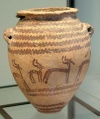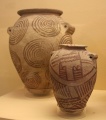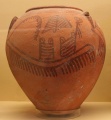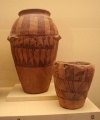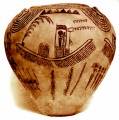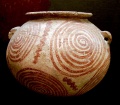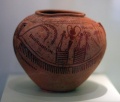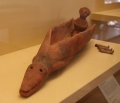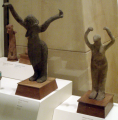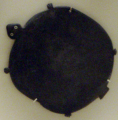Naqada II dell'Egitto
Da Ufopedia.
| Questa voce ha bisogno di essere tradotta. |
Gerzeh, also Girza or Jirzah, was a predynastic Egyptian cemetery located along the west bank of the Nile and today named after al-Girza, the nearby present day town in Egypt.[1] Gerzeh is situated only several miles due east of the lake of the Al Fayyum.[2]
The Gerzean culture is a material culture identified by archaeologists. The Gerzean is the second of three phases of the Naqada Culture, and so is called Naqada II. It is preceded by the Amratian (Naqada I) and followed by the Protodynastic or Semainian (Naqada III).
Though varying dates have historically been assigned by sundry authorities, Gerzean culture as used as follows distinguishes itself from the Amratian culture and begins circa 3500 BC lasting through circa 3200 BC or the end of the Naqada II period.[3] Accordingly some authorities place the onset of the Naqada I period coincident with the Amratian or Badarian cultures, i.e. c.3800 BC to 3650 BC even though some Badarian artifacts may in fact date earlier (for example, see Badarian). Nevertheless, because the Naqada sites were first divided by the British Egyptologist William Flinders Petrie, in 1894, into these Amratian (after the cemetery near El-Amrah) and Gerzean (after the cemetery near Gerzeh) sub-periods, the original convention is used in this text. This era lasts through a period of time when the desertification of the Sahara had nearly reached its present state (see Sahara).
The primary distinguishing feature between the earlier Amratian and the Gerzean culture is the extra decorative effort exhibited in the pottery of the period Artwork on Gerzean pottery features stylised animals and environment at a greater degree than earlier Amratian artwork Further, images of ostriches in the pottery artwork possibly indicate an inclination these early peoples may have felt to explore the desert of the Sahara.
Some symbols on Gerzean pottery resemble traditional hieroglyph writing, contemporaneous to pre-cuneiform Sumerian script.
Burial sites in Gerzeh have uncovered artifacts such as Cosmetic palettes, a bone harpoon, an ivory pot, stone vessels and several meteoritic iron beads.[4] Technologies at Gerzeh also fine ripple-flaked knives of exceptional workmanship. The meteoritic iron beads discovered in two Gerzean graves by Egyptologist Wainwright in 1911[5] are in fact the earliest artifacts of iron known[6] (see also Iron Age).
Lapis lazuli trade, in the form of beads, from its only known prehistoric source – Badakshan, in northeastern Afghanistan – also reached ancient Gerzeh.[7] Other discovered grave goods are on display here: [1], [2], [3].
One burial uncovered evidence of prehistoric dismemberment, in the form of a decapitation.[8]
The end of the Gerzean period is generally regarded as coinciding with the unification of Egypt.
Indice |
Galleria immagini
Notes
- ↑ Template:Cite web
- ↑ Template:Cite web
- ↑ Template:Cite book
- ↑ Template:Cite web
- ↑ Template:Cite web
- ↑ Template:Cite web
- ↑ Template:Cite web
- ↑ Template:Cite web
Bibliography
- Petrie/Wainwright/Mackay: The Labyrinth, Gerzeh and Mazghuneh, British School of Archaeology in Egypt XXI. London 1912
- Alice Stevenson: Gerzeh, a cemetery shortly before History (Egyptian sites series),London 2006, ISBN 0-9550256-5-6
See also
External links
- Gerzeh (Girza). University College London, 2000.
- Egypt, ancient. Encyclopædia Britannica, 2005.
